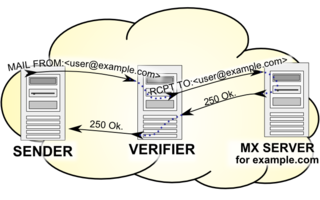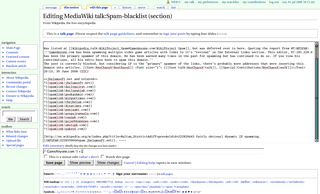spamd is an ISC-licensed lightweight spam-deferral daemon written under the umbrella of the OpenBSD project. spamd works directly with smtp connections, and supports features such as greylisting, minimising false positives compared to a system that does full-body analysis. spamd is designed to work in conjunction with pf(4), and should be fully functional on any POSIX system where pf is available, i.e. OpenBSD, NetBSD, FreeBSD and DragonFly BSD.
Spamd is most useful in preventing inbound spam from reaching mail servers. It can also be used as a partial application level proxy to ensure that external mail servers connecting to internal mail servers behave legitimately. Additionally, spamd can be very useful in preventing outgoing spam from systems that may be compromised or under the control of spammers.
It can be used to block spammers with the use of the following features:
The Simple Mail Transfer Protocol (SMTP) is an internet standard communication protocol for electronic mail transmission. Mail servers and other message transfer agents use SMTP to send and receive mail messages. User-level email clients typically use SMTP only for sending messages to a mail server for relaying, and typically submit outgoing email to the mail server on port 587 or 465 per RFC 8314. For retrieving messages, IMAP is standard, but proprietary servers also often implement proprietary protocols, e.g., Exchange ActiveSync.
A Domain Name System-based blackhole list, Domain Name System blacklist (DNSBL) or real-time blackhole list (RBL) is a service for operation of mail servers to perform a check via a Domain Name System (DNS) query whether a sending host's IP address is blacklisted for email spam. Most mail server software can be configured to check such lists, typically rejecting or flagging messages from such sites.
A tarpit is a service on a computer system that purposely delays incoming connections. The technique was developed as a defense against a computer worm, and the idea is that network abuses such as spamming or broad scanning are less effective, and therefore less attractive, if they take too long. The concept is analogous with a tar pit, in which animals can get bogged down and slowly sink under the surface, like in a swamp.
Various anti-spam techniques are used to prevent email spam.

Email spam, also referred to as junk email or simply spam, is unsolicited messages sent in bulk by email (spamming).
Greylisting is a method of defending e-mail users against spam. A mail transfer agent (MTA) using greylisting will "temporarily reject" any email from a sender it does not recognize. If the mail is legitimate, the originating server will try again after a delay, and if sufficient time has elapsed, the email will be accepted.

Postfix is a free and open-source mail transfer agent (MTA) that routes and delivers electronic mail.
Email harvesting or scraping is the process of obtaining lists of email addresses using various methods. Typically these are then used for bulk email or spam.
SORBS is a list of e-mail servers suspected of sending or relaying spam. It has been augmented with complementary lists that include various other classes of hosts, allowing for customized email rejection by its users.
Xtra Limited is New Zealand's largest Internet service provider (ISP). It was founded in 1996 and is a wholly owned subsidiary of Spark New Zealand. Xtra has provided dial-up Internet access throughout New Zealand since its inception in May 1996. In 1999 it created New Zealand's first ADSL service.
In computing, Bounce Address Tag Validation (BATV) is a method, defined in an Internet Draft, for determining whether the bounce address specified in an E-mail message is valid. It is designed to reject backscatter, that is, bounce messages to forged return addresses.
A challenge–response system is a type of spam filter that automatically sends a reply with a challenge to the (alleged) sender of an incoming e-mail. It was originally designed in 1997 by Stan Weatherby, and was called Email Verification. In this reply, the purported sender is asked to perform some action to assure delivery of the original message, which would otherwise not be delivered. The action to perform typically takes relatively little effort to do once, but great effort to perform in large numbers. This effectively filters out spammers. Challenge–response systems only need to send challenges to unknown senders. Senders that have previously performed the challenging action, or who have previously been sent e-mail(s) to, would be automatically whitelisted.

ISPConfig is a widely used Open Source Hosting Control Panel for Linux, licensed under BSD license and developed by the company ISPConfig UG. The ISPConfig project was started in autumn 2005 by Till Brehm from the German company projektfarm GmbH.
Nolisting is the name given to a technique to defend electronic mail domain names against e-mail spam.

Callback verification, also known as callout verification or Sender Address Verification, is a technique used by SMTP software in order to validate e-mail addresses. The most common target of verification is the sender address from the message envelope. It is mostly used as an anti-spam measure.

hMailServer is a free email server for Windows created by Martin Knafve. It runs as a Windows service and includes administration tools for management and backup. It has support for IMAP, POP3, and SMTP email protocols. It can use external database engines such as MySQL, MS SQL or PostgreSQL, or an internal MS SQL Compact Edition engine to store configuration and index data. The actual email messages are stored on disk in a raw MIME format. It has active support and development forums.
Backscatter is incorrectly automated bounce messages sent by mail servers, typically as a side effect of incoming spam.

In computing, a blacklist, disallowlist, blocklist, or denylist is a basic access control mechanism that allows through all elements, except those explicitly mentioned. Those items on the list are denied access. The opposite is a whitelist, allowlist, or passlist, in which only items on the list are let through whatever gate is being used. A greylist contains items that are temporarily blocked until an additional step is performed.
Since Internet users and system administrators have deployed a vast array of techniques to block, filter, or otherwise banish spam from users' mailboxes and almost all Internet service providers forbid the use of their services to send spam or to operate spam-support services, special techniques are employed to deliver spam emails. Both commercial firms and volunteers run subscriber services dedicated to blocking or filtering spam.
Stockade is a TCP-layer blocking tool written in C++. It denies TCP/IP access to registered IP addresses by using the ipfw packet filter. It targets spam prevention, but may also be used against other attackers